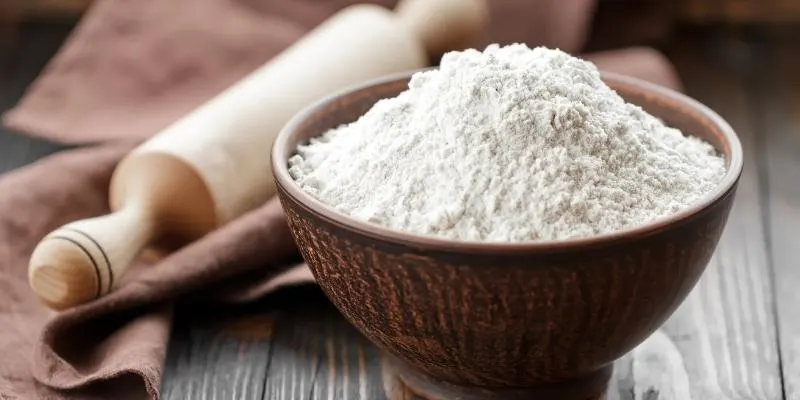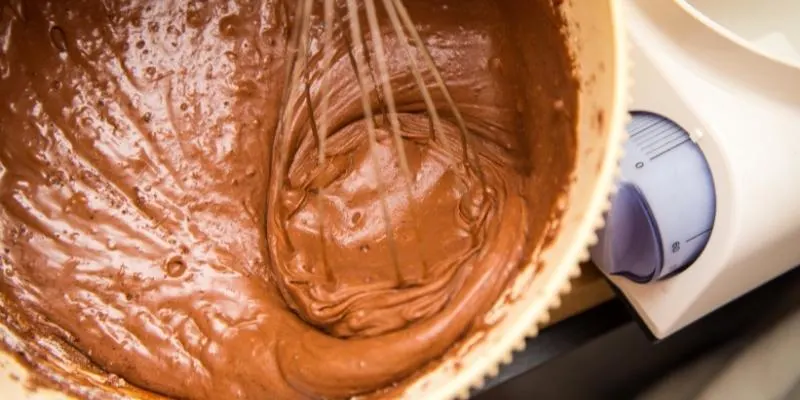Baking instructions can sound overwhelming when you’re not very familiar with each ingredient, and it certainly doesn’t help that you’re supposed to measure them very carefully. This is necessary, since baking walks a fine line between art and exact chemistry, and while there is room for error there is very little. So measuring what you use and knowing the fine difference between ingredients goes a long way. So today we’re taking a look at two of the most common ingredients in baking: baking powder, and baking flour.

Baking powder vs flour
Baking powder is a leavening agent, meant to help dough rise, while baking flour is the type of flour which higher protein content, meant for baking (as opposed to thickening sauces). You can bake with baking flour and without baking powder, but not with baking powder and without baking flour (or any flour at all).
Can you use baking powder instead of flour ?
No, baking powder does not have any actual flour in it and it will not actually provide you with dough. You need the flour for protein and carbohydrates to form the actual dough, and the baking powder to make it lighter and add volume, so it bakes all the way through. You cannot bake actual baking powder, since it will turn into a huge, bubbly, inedible mess and will have no substance to it.
To make an analogy, it’d be like trying to wash your hair with the lathering agent in shampoo, or attempting to paint only with paint thinner.
Read also: Do Bay Leaves Do Anything ?
What is baking powder ?
Baking powder is a leavening agent. It’s made of bicarbonate of sodium, a weak acid, and a starch to make sure it doesn’t react too quickly when added to a batter. The whole point of baking powder is to make the dough lighter, by releasing air bubbles into the dough as it heats and cooks, which in turn will help the batter less dense and more likely to cook on the inside as well.
If you were to skip baking powder entirely, the dough may not rise at all, to very little, depending on the recipe. A batter or dough of any kind need the air bubbles to cook through, evenly. Otherwise it will be too dense, and raw in the middle.
This is one of the most common problems of banana bread, for example. All banana bread recipes incorporate a lot of wet ingredients, and you need a lot of dry to offset the wet ingredients. This creates a very heavy and dense dough, which absolutely needs a leavening agent, and baking powder is pretty much the only leavening agent that does not add extra moisture and doesn’t add extra dry ingredients, it’s ”invisible” in the grand total of ingredients but its effect is noticeable.
And as you know, even with baking powder added, banana bread still takes double the time to cook through than other batter types.
Read also: Does Coconut Flour Rise ?
Is baking powder the same as baking soda ?
No, baking soda is an ingredient in baking powder. About 30% of baking powder is baking soda (sodium bicarbonate) to make things easier. Baking soda by itself still needs an acid (like lemon juice or vinegar) and a bit of starch to activate and later produce the carbon dioxide bubbles in batter.
So while you can use baking soda to bake, you need to be very careful with it, compared to baking powder. Where baking powder is a carefully measured and pre-made leavening agent mix, baking soda is just 1 out of 3 ingredients needed for the leavening to actually work.
Why do we need baking powder ?
Baking powder is meant to help anything with a lot of flour/gluten rise, and get the air bubbles we need to make a cake or bread lighter and fully cooked through. As the batter heats up, the air bubbles form and expand, thus helping it cook form the inside out as well. Baking powder ensures your bread won’t be extra dense, will rise, and will fully bake all the way through.
There are options if you don’t want to use baking powder at all, and all of them require protein, be it from egg white, flax seeds, or aquafaba (chickpea water). All three help raise batter, as long as you whip a lot of air into them. Unlike baking powder, these are not heavy duty and won’t be able to raise a heavy, dense batter as well as baking powder.
But you can always adjust your batter to incorporate less flour, which in turn will require you to use less wet ingredients otherwise the whole thing won’t bake at all. There is a perfect ratio of wet to dry in baking, and baking powder is the best way to ensure you don’t mess it up.

Bubbles in cake batter due to baking powder.
What is baking flour ?
Baking flour is any flour that is meant for baking, and this usually means very finely ground flour, as opposed to some coarser ground flour. Flour can be made of any ingredient such as grains, beans, nuts, but the most common types are grain-based and that is usually wheat. It’s the protein in the flour that helps it rise and create the bubble network, which is what helps it keep it structure. In most flours the protein is gluten, which creates the gluten network.
Gluten-free flours still have protein, but not gluten. It doesn’t work as well to create a stable, chewy texture (for bread) but they still make a dough that rises and bakes through very well. In general, you need higher protein content (of any kind) in the batter you’re going to bake, since it’s meant to hold a structure. So baking flour, in general, will have more protein than other flours, and bread flour will usually have the most protein since it needs the extra help.
Read also: Quinoa Flour Substitutes
You can get self-raising flour to make things easier
If you don’t want to measure baking powder for flour, you can get self-raising flour. This type of flour has a ratio of baking powder to flour already calculated and added into the package, so you don’t need to add any more baking powder. But it also means you cannot control the amount of rise in your batter. That is going to be dictated by the self-raising flour.
In most cases the batter will rise just fine, it won’t be too dense or too light. In case you do want a lighter or denser cake or bread, you will need to add a bit more plain flour, or an extra couple of grams of baking powder.

